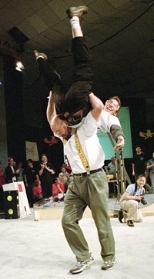A unique four-wheel drive robot painted with a toothy grin like a WWII bomber and designed to work like a force of nature won first place in "Schwing!" the 2002 version of 2.007, MIT's famed machine design contest.
This year's student winner was Martin Jonikas, a sophomore from Berkeley, Calif. His machine, known as "Bomb-Totin' Mama," triumphed in a field of 120. Other victors in the Final Four were Aaron Parness, second place; Henry Hilton, third place; and Eric Dominguez, fourth. All are sophomores in mechanical engineering. A winner's trophy was awarded to Professor Ernesto Blanco also, for his 25 years of inspiration to young mechanical engineers (see related story on page 8).
"Schwing!" was emceed by Professor Alexander H. Slocum of mechanical engineering, a MacVicar Faculty Fellow, who wore his signature Panama hat, Dilbert tie and measuring tape suspenders while making his human-boombox-like commentary.
"Ignore all the bad news you read. This is about these students--power-geeks rule! That's why we're here! Look at what comes out of this and you know we'll be okay," Slocum declared to the packed bleachers in Johnson Athletic Center last Wednesday, May 8.
"Let's fire these puppies up! Let's hear it for happy linkage design! Check out those climber-cranker Super Spinners," Slocum added as the first round of machines hit the tables for the 32nd annual machine design contest.
"Schwing!" offered a new twist in the ever-changing, ever-evolving 2.007 contest rules. Contestants could score in two ways: by placing maximum weight into bins at either end of the carpeted table "field" or by forcing a PVC pendulum to swing back and forth like a doomsday metronome.
Hockey pucks and street hockey balls made the terrain more fiendishly challenging.
Jonikas, elated by victory, autographed street hockey balls for young fans after the night's final round.
He later described his strategy as "beautifully simple and deadly" and his machine as a triumph of "10 years of backyard tinkering" streamlined by robust and effective guidelines for engineering design provided by Slocum.
"I was so happy. It was a very ambitious project. There were several times when I thought it was hopeless, some crucial little part wouldn't work so I would have to drop it all. But I stuck with it, and in the end it all worked exactly as designed. It was a great experience as an engineer," Jonikas said.
Jonikas thanked his parents for "drowning me in LEGOs as a kid," his high school physics teacher and friends for putting together an "awesome U.S. FIRST robotics team my senior year," and Col. Pete Young, a senior lecturer in aeronautics and astronautics, for encouraging him "through some crazy aerospace projects."
TWO STRATEGIES, ONE SMOOTH GROOVE
Jonikas and fourth-place winner Dominguez both described the workings of their machines in careful detail after the contest. This is the well-grooved path of most 2.007 winners: some can describe their machines decades after winning the contest.
Jonikas explained his strategy for scoring by pushing down on the scale. "My pusher mechanism used a winch and pulleys to generate 85 pounds of force over a 2-inch range. While the machine drove to the wall, it was horizontal. When I had rammed into the wall and locked on, I activated the pushing mechanism. An added cool feature was the ability of my robot to completely detach from the pushing mechanism once it was activated, like a bee's stinger," he said.
Dominguez went for the "flapper" style machine; his goal was to rack up points by getting the pendulum to 'schwing' and dump balls into the weigh-in bin. Slocum dubbed this style the "pendu-bot."
"To cause the balls to shoot out of the pendulum and into my bin, I locked the pendulum in place with my flapping mechanism. At the beginning of the round I would spin my flapper out of the pendulum's way. This caused the pendulum to swing to the angle needed to get the balls to fall into my bin. After that I would just hit the pendulum with my flapping mechanism and try to rack up the points," Dominguez said. "I was very excited to be one of the Final Four."
The four finalists plus two other contestants will participate in the annual International Design Competition, to be held this summer at MIT.
A version of this article appeared in MIT Tech Talk on May 15, 2002.






